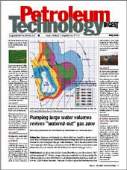|
| |
May 2000 Supplement
Contents
|
|
 |
 |
About the Petroleum Technology Digest
Case studies for Independent Producers |
 |
Pumping large water volumes revives "watered-out" gas zone
Brian Collins, Dave Boneau and Pinson McWhorter, Yates Petroleum Corp., Artesia, New Mexico |
|
Operators in the huge Indian Basin field have found that significant volumes of gas can be produced far behind the encroaching water front by pumping large volumes of water along with the gas. Yates Petroleum, one of the early users of this "secondary-gas" technology, is producing about 38 MMcfd from a two-section area where the carbonate reservoir lies 200 ft below the current water-gas contact. |
 |
Sound technology and better regulation make field development economical
Brian Sims, Independent, Madison, Miss.
|
|
Improved reservoir definition from 3-D seismic, combined with progressive regulation allowing reservoir-based spacing units, enabled Spooner Petroleum Co. to develop Ollie field, a Norphlet play in southwest Alabama. Lower development costs with reservoir-based spacing units made field development economical. Horizontal lateral technology in the second development well allowed it to reach favorable reservoir development, precluding a potential dry hole. |
 |
How to cut electrical power costs by 30% with little or no investment
James C. "Chris" Hall, Drilling & Production Co., Torrance, Calif. |
|
Operator experience confirms that low-tech, low-cost actions can reduce electrical power costs by as much as 30% or more, when applying simple, good business management practices and monitoring their operations. |
 |
Alternative artificial lift system improves well profitability
Brian Fox, Renco Energy, Inc., Tulsa, Okla.; and Gerold Allen*, Toups Technology Licensing, Inc., Claremore, Okla. |
|
A balanced, oil recovery, artificial lift system improved well profitability by lowering operating costs and increasing oil production in problem wells in northeastern Oklahoma. Water production with its associated costs and, in some instances, well servicing costs were lowered, as were electrical power costs. Five uneconomical wells were converted into profitable producers. |
 |
Microbial permeability profile modification extends life of oil field
James O. Stephens, Hughes Eastern Corp., Jackson, Miss.; and Lewis R. Brown and A. Alex Vadie, Mississippi State University, Starkville, Miss. |
|
Microbial permeability profile modification technology is being used to improve reservoir sweep and recovery in the North Blowhorn Creek Unit Carter Sandstone waterflood in Alabama. Inorganic nutrients are being injected to stimulate growth of in situ microbes. This process diverts injection, thereby improving sweep efficiency. After five years, field life has been extended an additional five to 10 years or more. |
 |
Surface geochemical survey adds exploration confidence
William H. Shepherd, Oil Producers Inc., Wichita, Kansas, and J. Lynne Davison*, Pangaea Geochemical Technologies, Inc., Wichita, Kansas |
|
Surface-hydrocarbon-soil-gas data provided extra confidence that adequate reservoir quality existed at a step-out drilling location of a structural / stratigraphic-controlled Mississippian dolomite play. Data were gathered using patented K-series gas-sieve technology from Pangaea Geochemical Technologies, which concentrates soil gas readings and provides greater discrimination. |
|



